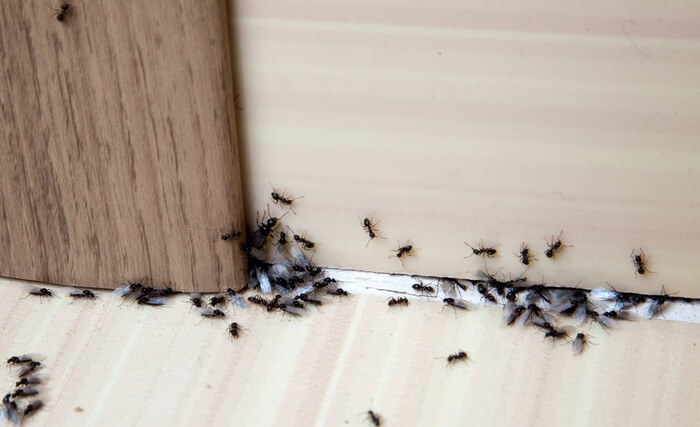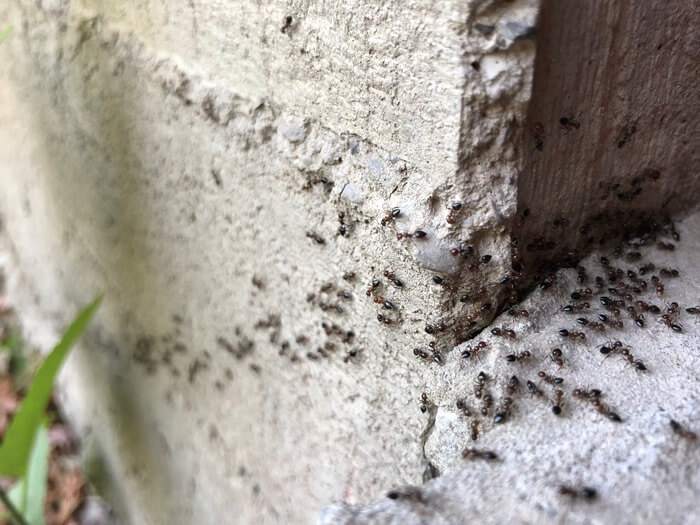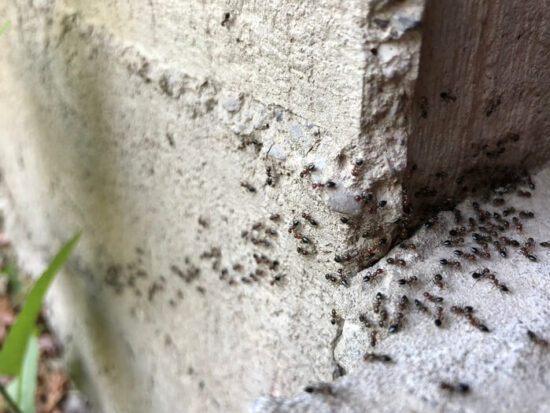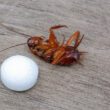Learning how to get rid of ants in walls isn’t a skill that you want to learn, but sometimes it’s necessary. Ants are an extremely common pest that can make their way into even the most well-defended home.
This guide will teach you everything you need to know about ants in walls. You’ll learn why walls are such an appealing spot for ants, how to determine if you have an infestation, and ways to get rid of them.
Table of contents
Why Ants Like Living in Walls
Most people shudder at the thought of having insects crawling up the walls. While that may seem like the stuff of nightmares, it’s a cold reality for many homeowners!
Believe it or not, ants are one of the most common wall-dwelling pests. These insects are pretty adaptable and will quickly adjust to whatever environment is best for their survival. Sometimes, that’s outside in a deep underground nest. But other times, it’s the comforts of your home.
There’s a reason why you’ll often find ants in walls. These insects prefer to live in warm, moist locations. Your walls naturally collect residual heat from the controlled environment inside, making it a cozy site for ants (and hard for you to get rid of them).

Not only that, but it provides quick and easy access to all the things they need to survive! That includes food, water, and more. If the wall houses a leaking pipe, the new home only gets sweeter!
- Kills common household ants including acrobat, crazy, ghost, little black, odorous house, pavement, and other sweet-eating ants
- As worker ants discover the bait, they share it with the rest of the colony to eliminate them all
- You should see a significant decrease in the number of ants visiting the bait stations within just a few days
- Place stations near areas where you’ve seen ant activity
In many infestation cases, ants make their way into walls because they found an easy access point. The ants could have followed a scent trail to food crumbs or sugary sweets. Alternatively, they could have migrated due to the safety of your house to avoid harsh weather and challenging living conditions.
Whatever the case may be, these pests stick around because they find an opportunity to take shelter in your walls.
Ants typically enter small voids, cracks, and gaps. Those entry points could be from the inside of your home, exterior walls, or even in non-supporting walls. Either way, those small voids can give an entire colony carte blanche to set up shop.
Quick Tip: If you’re wondering how these insects navigate vertical spaces, you’d be surprised at how adept they are. Most species have tiny hooked claws on the end of their feet. As a result, climbing up 90-degree inclines is no problem for ants!
How To Know If You Have Ants In Your Walls
Like many household pests, ants are masters of evasion. They have a knack for staying hidden in the shadows and staying out of sight.
So, how do you know that you have ants in your walls that you need to get rid of? Look out for these telltale signs.
Visible Ant Trails
The most apparent sign of ants in your walls is spotting them with your own two eyes! It’s not uncommon to see ants out and about during the day. Some species like to forage at night, but others delegate scouting roles around the clock.
Usually, ants appear in neat lines. These pests are very organized and like to work by trailing one after another.
When ants reside in your walls, they have to come out sometime to find food and water. Catching them in the act will make you aware of their presence. Plus, you can follow the trail to see exactly where these ants are navigating (helping you get rid of them later).
Sudden Ant Evacuations
Ants respond to external sounds and vibrations like any other pest. If you accidentally bump into the wall, don’t be surprised to see those critters pouring out of their access point.
Many homeowners inadvertently find ants when hanging pictures or moving furniture. However, you can purposely test to see if ants respond. Just knock on the walls lightly throughout your home.
While you’re doing so, you can test for the next telltale sign.
Hollow Structural Components
Many ant species will burrow directly into the wood to create nests. Carpenter ants are the worst offenders, but other species will chew through cellulose as well.
Contrary to popular belief, burrowing ants don’t always eat the wood. Many prefer to find damp or moist wood that’s already damaged. Once they find weak wood, they expand the tunnels to create their nest.
- Kills common household ants including acrobat, crazy, ghost, little black, odorous house, pavement, and other sweet-eating ants
- As worker ants discover the bait, they share it with the rest of the colony to eliminate them all
- You should see a significant decrease in the number of ants visiting the bait stations within just a few days
- Place stations near areas where you’ve seen ant activity
Unfortunately, ants will continue to burrow into healthy wood to make nests bigger as the colony grows. When this happens, a lot of the wall’s structural integrity is hanging on by a thread!
Tapping on the wall studs may reveal a hollow sound. That indicates that the wood holding your walls up is already severely damaged.
Piles Of Dust & Wood Pellets
Remember how we said that not all ants eat wood? Carpenter ants only chew on cellulose to excavate the wood. They don’t consume it or digest it.
As a result, you’ll find little piles of wood near their nest. These piles usually appear as fine dust or tiny round pellets. In most cases, you can spot them along baseboards or cracks in the wall.
Quick Tip: Look a little deeper, and you’ll likely find the entry point they use to get into the wall.
Audible Movement
Here’s something you don’t want to experience.
Ants are tiny creatures that can move without making any noise at all. But when they’re chewing through the wood in your walls? That’s a different story.
Carpenter ants are notorious for producing chewing sounds. Thanks to the hollow design of most walls, the noise can resonate in a quiet room.
Don’t ignore those uncomfortable scratching noises! Make a note of where they are, as that can help you find the nest’s location.
Malodorous Aromas
Lastly, take some time to see if you notice any strange odors.
Some ant species can give off a distinct aroma. A few even have a disgusting smell of formic acid when crushed. Others smell like rotten coconuts or citronella!
You would never notice the smell of only a few ants in your walls. But if you’re dealing with a large colony, there’s a good chance that the odor lingers. This is especially true if some of the ants died when creating the colony’s home.
Species You’ll Typically Find
The ant kingdom is surprisingly vast. While there are more than 10,000 known ant species worldwide, only about 25 are known to infest homes. Of that 25, the list gets narrower when discussing species of ants that are capable of living in walls.
Here are some of the most common wall-dwelling ant species and how to identify them.
- Acrobat ants: Acrobat ants are pale brown to dark black. They’re about three millimeters long and prefer to nest in wooden doors, door frames, and window frames. For food, these ants like sweets and protein-based meals.
- Argentine ants: Measuring as small as two millimeters, Argentine ants are discrete. They gravitate towards warm areas and like to eat sugars, carbohydrates, and grease. They like to invade plumbing traps and wall insulation.
- Carpenter ants: Carpenter ants are black or brown and can measure up to half an inch long. Feeding on sweets, carbohydrates, and other insects, these ants can invade any wooden structural component. They make huge nests and can even create smaller satellite nests (making them a pain to get rid of).
- Crazy ants: Known for its unpredictable movements, the crazy ant often lives in wall voids. It can also reside in potted plants. They measure about three millimeters long and have a reddish-brown body.
- Flying ants: Appearing during mating season, Flying ants can invade homes in large swarms. They consume sweets and regularly get into tiny cracks and crevices in walls.
- Ghost ants: Ghost ants have a dark head and a pale lower portion. They’re only about one and a half millimeters long. This species eats sweets and grease. Frequently, they come into homes through firewood before swarming plants, kitchen cabinets, and walls.
- Citronella ants: Citronella ants are said to give off a citrus scent when crushed. They’re usually brown and come from underground habitats below basements and foundations before getting into homes. They typically eat insects like mealybugs.
- Little black ants: Only a few millimeters long, little black ants are unassuming. They often nest in wall voids, veneers, and cabinets. They’re most attracted to food remnants.
- Odorous ants: Feeding on sweet and carbohydrates, odorous ants nest in wood that’s already damaged. They can also make homes in pipes and trap drains. When crushed, odorous ants give off a strong aroma of rotten coconut.
- Pavement ants: Pavement ants are black or brown. The body features two frontal nodes and a couple of distinct hair clusters. This species prefers to live in walls, under floors, foundations, and inside cracks of sidewalks.
- Pharaoh ants: Pharaoh ants are less than two millimeters long and are usually light red to yellow-brown. They feed on proteins and sweets. As a result, you can generally find them in kitchens or bathrooms where food and water are near.
- Sugar ants: Sugar ants are any ant that feeds exclusively on sugars. They can be yellow, brown, reddish-brown, or black. Most follow sweet trails and build nests in any available wall void.
How To Get Rid Of Ants In Your Walls
So you find yourself dealing with an infestation of ants in your wall. How do you get rid of them?
Fortunately, there are several ways to deal with ants in your walls. These pests are resilient, but you can perform many extermination steps to eradicate the existing population for good.
Clean Your Home
Before you do anything else, consider cleaning up anything that might attract other ants. These insects multiply very quickly. Cleaning your home of food scraps and crumbs can deprive them of the fuel they need to flourish, meaning they’ll have no reason to set up shop in your walls
While cleaning won’t eradicate the population, it will slow them down. Cleaning buys you some time and ensures that more ants don’t move in.
Pay special attention to the kitchen and bathroom. Take a vacuum to every surface and use a sanitizing solution to eliminate scent trails.
Set Up Traps
Next, we recommend setting up some traps and bait stations.
- Kills common household ants including acrobat, crazy, ghost, little black, odorous house, pavement, and other sweet-eating ants
- As worker ants discover the bait, they share it with the rest of the colony to eliminate them all
- You should see a significant decrease in the number of ants visiting the bait stations within just a few days
- Place stations near areas where you’ve seen ant activity
Bait traps can work wonders to kill entire colonies. You see, they don’t work instantly. When an ant eats some bait food, they remain healthy enough to bring it to the rest of the nest in your walls.
When this happens, the toxic bait food spreads like wildfire to affect hundreds of ants in one go!
There are several different kinds of traps out there. You can use granular products, gels, and liquid baits. They all have similar levels of efficiency.
What you need to pay attention to most is the bait food. Some ants feed exclusively on sugar or protein. Here’s where knowing ant species comes in handy!
You must match the bait food to the ants you’re dealing with if you want to see the most success.
Quick Tip: Put the traps near entry points and leave them be. Give the bait a few days, and you should see a noticeable difference in the number of ants you have.
Find The Colony & Gain Access
If you’re tackling more stubborn ant infestations in your walls, you may have to find the nest and gain access to it. This technique is best reserved for a professional ant exterminator if you’re unfamiliar with ant species and their habits.

Usually, carpenter ants are the ones that need a little more work to kill and get rid of. These ants can burrow so deep into the wall that they’re inaccessible by conventional means.
After finding the nest, the ideal technique is to bore several holes into the structure so that you can apply insecticide or traps efficiently.
Liquid Insecticide Sprays
Liquid insecticides are one of the most efficient products you can use to get rid of ants in walls. They’re readily available at most stores. Plus, some brands make formulas geared towards particular species.
You have two liquid insecticide options:
- The first is instant-kill contact products. As you can guess from the name, these sprays kill all visible ants in the area. While effective, you can only kill the ants you see.
- The second option is non-repellent liquid sprays. They’re invisible killers that coat the ant but don’t do any harm. The sprayed ants stay alive, ensuring that the deadly product makes its way back to the nest for the slow kill.
Use Insecticide Powders
Powders and dusts are an effective choice, too.
They work a couple of different ways. Like liquid sprays, some kill instantly. However, others are designed to get rid of the entire colony.
Quick Tip: A powder product may be easier to apply inside cracks and voids. However, some are staining and can become a safety risk during application. Something to keep in mind when you decide which is ideal for you!
Seal Holes & Cracks
Once you’re done applying your insecticides and setting up traps, seal up every access point.
Do a thorough inspection of your walls from both sides. Address any issue that even remotely looks like an ant could take advantage of. That means filling cracks, sealing holes, and fixing leaks.
Don’t forget to pay attention to the quality of your existing structural wood. If you notice anything damaged by ants, moisture, or even termites, consider replacing it to keep new ant infestations at bay.
Treat Outside Nests
Finally, it’s important to never neglect your yard!
Ants start their journey outside before making their way into your walls. One of the best ways to stop ants from invading your home is to get rid of as many in your yard as possible.
Treat nests and consider applying insecticides several feet around the perimeter of your house. Repeat the process a few times a year to take care of new bugs that appear during the mating seasons.
Methods To Get Rid Of Them Naturally
Are you looking to take on a more natural approach? You don’t have to rely on chemicals if you don’t want to.
One of the best ways to keep ants out is to take advantage of natural repellents. Several plants deter ants from invading your home (and they’re about as eco-friendly as it gets). They give off a strong aroma that these insects can’t stand!
Plants like peppermint, cinnamon, cayenne pepper, and catnip are some of the most common cultivars. Anything that gives off a pungent fragrance will do!
Use the plants strategically around your exterior walls to create an invisible barrier that ants won’t want to cross.
To deal with existing ant infestations in your walls, you can use all-natural sprays. The most straightforward formula is an even mixture of white vinegar and water. Alternatively, you can use water with a few drops of peppermint essential oil or lemon juice.
Quick Tip: Spray the solution on the ants directly when possible. Then, apply it to the wall void, nesting spots, and entryways. Many like to spray around doors and windows as well.
If liquid sprays aren’t your thing, diatomaceous earth is a fantastic natural insect killer. Available in powder form, it effectively suffocates ants. It takes a little while to dehydrate the insect, so it often ends up in nests, too.
Our final natural extermination tip is to make your own bait trap. Borax does a fantastic job of killing ants and other insects. Mix it with equal parts sugar for a pure powder bait food, or use some peanut butter for a stickier consistency.
Either way, place the bait food near the ants’ scent trail. Before you know it, the food will make its way to the nest!
Closing Thoughts
You don’t want to spend time getting rid of ants in your walls, but sometimes it’s necessary. If left unchecked, these tiny insects can do a surprising amount of damage to the structure of your home.
Let us know if you have questions about any of the recommendations you see above. We’re more than happy to help!



